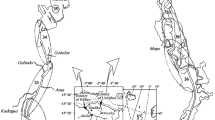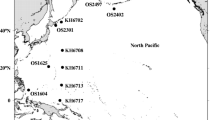Abstract
The calanoid copepod community was surveyed semi-monthly, from May to July 1992, at three stations in the Navesink-Shrewsbury rivers system, the southernmost branch of the Hudson-Raritan estuary (New York-New Jersey). The dominant species collected during the survey wasAcartia hudsonica, followed byA. tonsa. A comparison of this survey with three earlier surveys suggests that the calanoid copepod community and relative abundance of dominant species have not changed substantially since the 1960s. Findings from a 1972 study, which noted the absence ofA. hudsonica andPseudodiaptomus coronatus as dominant species, were probably reflecting a temporary situation. The variations may have been related to a change in water quality, caused by an upgrade in sewage treatment, completed just prior to the 1972 survey, and/or resulted from the residual effects of Tropical Storm Agnes on this estuary.
Similar content being viewed by others
Literature Cited
Allen, R. 1992. Navesink River striped bass restoration. New Jersey Department of Environmental Protection and Energy, Division of Fish, Game and Wildlife, Nacote Creek Research Station, Port Republic, New Jersey.
Andrews, J. D. 1973. Effects of Tropical Storm Agnes on epifaunal invertebrates in Virginia estuaries.Cheseapeake Science 14:223–234.
Boesch, D. F., R. J. Diaz, andR. W. Virnstein. 1976. Effects of Tropical Storm Agnes on soft bottom macrobenthic communities of the James and York estuaries and lower Chesapeake Bay.Chesapeake Science 17:246–259.
Corkett, C. J. andI. A. McLaren. 1978. The biology ofPseudocalanus.Advancements in Marine Biology 15:1–231.
Jeffries, H. P. 1962. Succession of twoAcartia species in estuaries.Limnology and Oceanography 7:354–364.
Jeffries, H. P. 1967. Saturation of estuarine zooplankton by congeneric associates, p. 500–508.In G. H. Lauff (ed.), Estuaries. American Association for the Advancement of Science, Special Publication 83. Washington, D.C.
Knatz, G. 1978. Succession of copepod species in a Middle Atlantic Estuary.Estuaries 1:68–71.
Phelan, B. A. 1992. Winter Flounder movements in the inner New York Bight.Transactions of the American Fisheries Society 121: 777–784.
Sage, L. E. andS. S. Herman. 1972. Zooplankton of the Sandy Hook Bay area, N.J.Chesapeake Science 13:29–39.
Steimle, F. W. andJ. Caracciolo-Ward. 1989. A reassessment of the status of the benthic macrofauna of the Raritan Estuary.Estuaries 12:146–156.
Uye S. andA. Fleminger. 1976. Effects of various environmental factors on egg development of several species ofAcartia in Southern California.Marine Biology 38:253–262.
Yamazi, I. 1966. Zooplankton communities of the Navesink and Shrewsbury rivers and Sandy Hook Bay, New Jersey.Bureau of Sport Fisheries and Wildlife Technical Paper 2:1–44.
Author information
Authors and Affiliations
Additional information
Corresponding author.
Present address: 15 Wigwam Road, Locust, New Jersey 07760.
Rights and permissions
About this article
Cite this article
Shaheen, P.A., Steimle, F.W. Trends in copepod communities in the Navesink and Shrewsbury rivers, New Jersey: 1962–1992. Estuaries 18, 250–254 (1995). https://doi.org/10.2307/1352635
Received:
Accepted:
Issue Date:
DOI: https://doi.org/10.2307/1352635




